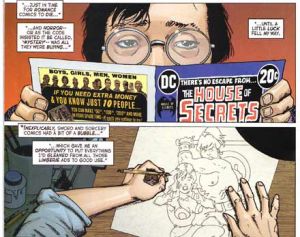- Comics
- Comics Reviews
- Manga
- Comics Reviews
- European Comics
- News
- Comics News
- Press Releases
- Columns
- Spotlight
- Digital Comics
- Webcomics
- Cult Favorite
- Back Issues
- Webcomics
- Movies
- Toys
- Store
- More
- About
By Philip Schweier
March 20, 2010 - 05:30
On Feb. 19 and 20, the Savannah College of Art & Design hosted Howard Chaykin and Klaus Janson, who presented a two-day seminar originally conceived for Marvel Comics. The purpose of the seminar is to introduce new comic artists and Marvel editors, some of whom come from an editorial background and lack the experience to effectively judge comic book techniques, to basic tools of effectively telling a story in the comic book form.
Janson points out that one of the things that happens to an artists as an insider, “is you don’t look at work anymore with the same objectivity or disconnection as you did when you were a fan.
“We’re on the inside now and you guys are on the way to being on the inside, and if you look at work, you generally tend to analyze it, instead of enjoying it first. You start to look at ‘What’s he doing, look at this page, look at that shot, look at the use of depth’ or something.
Janson cites J.H. Williams as the closest modern-day equivalent to Steranko and Adams. “J.H. Williams is dazzling in his technique and in his choices and in his graphic quality of his page layout. There is a certain excitement to it. I’m not sure I would make those choices, but I can certainly recognize the excitement he brings to his work.
Chaykin pointed out that there are a number of talented storytellers, who happen to not be fan favorites, but that might be due to a lack of sophistication among some fans, especially younger ones, arguing that the stereotype of the typical fan is 12-14 years old.
“It’s important to know what your audience is into,” added Janson, “and your audience does not understand composition, does not understand storytelling. They like detail. They like lines, they like things, they like shiny stuff. If you do Iron Man and you do shiny armor, they love that, they think you’re a great artist.”
Janson expalins that an artist’s developmental arc starts from the same place as the fans, which is an interest in detail and spectacle. “But the real meat of your talent should be directed toward storytelling,“ he says, “something the fans don’t really understand, and they can’t understand it because it’s not their job. They want to be entertained, they want to be immersed in the detail and color, and the ‘Aquaman looks like Brad Pitt, isn’t that cool.’
Janson insists the artist’s job is to tell the story, so there is a separation between an artist and the audience. “You have a higher calling than just being a person who produces spectacular work for the fans. You’re supposed to be artists.”
 |